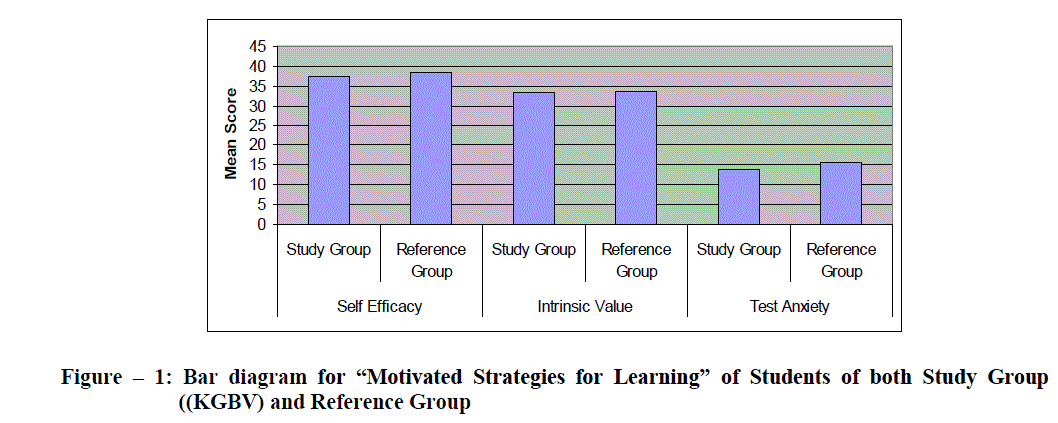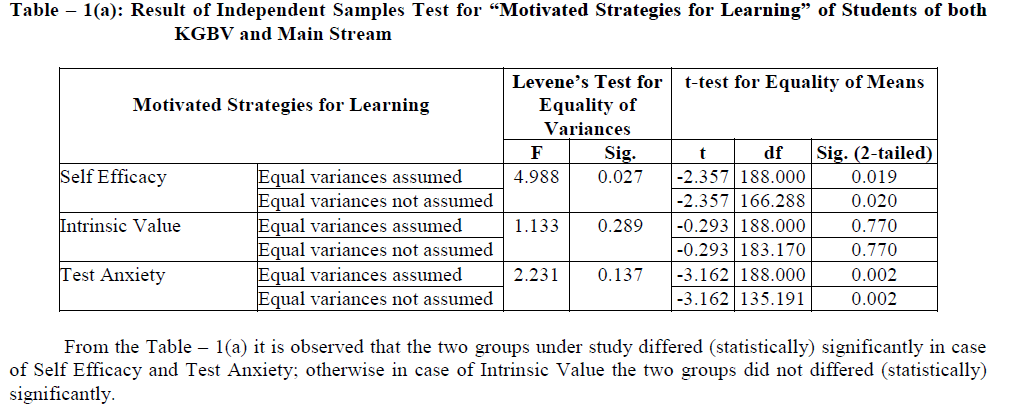ISSN ONLINE(2319-8753)PRINT(2347-6710)
ISSN ONLINE(2319-8753)PRINT(2347-6710)
Kajal Das1 Sayed Nurus Salam2 Samirranjan Adhikari3
|
| Related article at Pubmed, Scholar Google |
Visit for more related articles at International Journal of Innovative Research in Science, Engineering and Technology
Generally, motivation underlies behaviour that is characterized by willingness and volition. Kasturba Gandhi Balika Vidyalaya (KGBV), residential schools which cover hard to reach girls especially the deprived ones belonging predominantly to the SC, ST, OBC community and minority groups act as extrinsic intervention. The main objective of the study was to compare the motivational aspects between the girl-students of Kasturba Gandhi Balika Vidyalaya and their general counterpart. By applying the Motivation Strategies for Learning Questionnaire (MSLQ), this study explored differences in self-efficacy, intrinsic value and test anxiety between the two groups of students through descriptive survey method within ex-post-facto research design. No statistically significant difference in intrinsic value was observed. But in case of self efficacy the general students had significantly higher mean of the scores, whereas in test anxiety the KGBV group had significantly lower mean of the scores. KGBV scheme seemed to be effective in making the deprived group to rise up to the level of general group.
Keywords |
| Motivation, Intrinsic Motivation, Extrinsic Motivation |
I. INTRODUCTION |
| Motivation refers to reasons that underlie behaviour that is characterized by willingness and volition. Intrinsic motivation is animated by personal enjoyment, interest, or pleasure, whereas extrinsic motivation is governed by reinforcement contingencies. Motivation involves a constellation of closely related beliefs, perceptions, values, interests, and actions. Motivation within individuals tends to vary across subject areas, and this domain specificity increases with age. Motivation in children predicts motivation later in life, and the stability of this relationship strengthens with age. Traditionally, educators consider intrinsic motivation to be more desirable and to result in better learning outcomes than extrinsic motivation. In general, children appear to enter school with high levels of intrinsic motivation, although motivation tends to decline as children progress through school. Research suggests that motivation can be manipulated through certain instructional practices, although studies demonstrate both positive and negative effects. The use of rewards may either encourage or diminish motivation, depending on the type of rewards and the context in which they are given. Teachers should attempt to give students more autonomy or control over their own learning by allowing them to make choices and use collaborative or cooperative learning approaches. In addition, teachers should create a supportive classroom environment with respect to goal structures, attributions, and external evaluation. There are several challenges to assessing motivation, especially in children. Recommendations for eliciting evidence of motivation for assessment purposes are made. According to Gottfried (1990) [1] academic motivation is enjoyment of school learning characterized by mastery orientation, curiosity, persistence, task-endogen and the learning of challenging, difficult, and novel tasks. Intrinsic motivation is animated by personal enjoyment, interest or pleasure, whereas extrinsic motivation is governed by reinforcement contingencies. |
| Kasturba Gandhi Balika Vidyalaya is residential schools which cover hard to reach girls especially the deprived ones belonging predominantly to the SC, ST, OBC community and minority groups. This is an extrinsic intervention for girls residing in small and scattered habitations far off from the nearest school, who have remained outside the educational system despite interventions of other government programmes due to persistent socio-economic, cultural and topographical reasons. |
| Objective of the Study |
| The main objective of the study was to compare the motivational aspects between the girl-students of Kasturba Gandhi Balika Vidyalaya and their general counterpart. |
 |
II. METHODS |
| The present study was carried out through descriptive survey method within ex-post-facto research design. The details regarding sample, tool, procedure of data collection and statistical technique are reported hereunder. Variables |
| In the present study following variables were considered. |
| Independent Variable |
| Independent Variable is the “Cause” in the “cause and effect” relationship. This is actually manipulated by the researcher. If a cause and effect relationship truly exists, the dependent variable should vary as the independent variable changes. An independent variable has at least two values and may have more. Each value of the independent variable is called a level. |
| In the present study “independent variable” was the “Kasturba Gandhi Balika Vidyalaya (KGBV) Scheme”. Here two levels were considered – (a) beneficiary of the scheme (study group) and (b) non-beneficiary of the scheme (reference group). |
| Dependent Variable |
| Dependent Variable is the “Effect” in the “cause and effect” relationship. It depends on the independent variable. It is usually the variable that is measured at the end of a study. |
| Followings were the “Dependent Variables” in the present study – |
| a) Self-efficacy, |
| b) Intrinsic value, and |
| c) Test anxiety |
| Subject Related Variables |
| These are the characteristics or attributes of participants that cannot be manipulated by the experimenter. Gender, IQ, ethnicity, age, etc, are the examples of subject related variables. Subject related variables cannot be independent variables. The researcher cannot control and only can assign them or determine “how much” of one a person will have in a study. Because of this, “cause and effect” statements should never be made based on a subject related variables. A researcher cannot know if a change is actually due to the subject related variables or to some other, alternative explanation (an extraneous variable). |
| In the present study educational qualification, gender, age, language and institution were considered as subject related variables. Sample |
| For the sake of the research the respondents of the study acted voluntarily. The source of the sample, sample size and sample characteristics are reported hereunder. Source |
| The KGBV scheme has been introduced in four Educationally Backward Blocks (EBBs) in the district of South 24-Parganas, West Bengal, namely, Janapriya Nagar Janapriya Vidyalaya, Howramari High School (H.S), Nalgora Baikuntha Dham Bidyapith, Jamtola Bhagaban Chandra High School in four Educationally Backward Blocks, Basanti, Canning-2, Joynagar-2 and Kultali respectively. South 24-Parganas has adopted Model-3 where the hostels are located next/close to the Senior Secondary Schools in the village. These schools were selected for the present study. |
| a) For Study Group the hostel dwellers under Kasturba Gandhi Balika Vidyalaya (KGBV) scheme were considered. |
| b) For Reference Group the female day scholars of the schools where KGBV Scheme launched were considered. Sample Size |
| Sample Characteristics |
| a) Female students of Class VI, VII & VIII of age group 11 – 15 yrs. were taken. |
| b) Only Bengali speaking students were taken. |
| Sampling Procedure |
| Out of the total female students only 95 hostel dwellers and 95 day scholars were selected randomly. Tool of Research |
| The following research tool was used in the present study for data collection. The tool was selected by applying yardsticks of relevance, appropriateness, reliability, validity and suitability. Brief description of the tool is given hereunder. |
| Motivated Strategies for Learning Questionnaire (MSLQ) (Pintrich & De Groot, 1990) [2] |
| The MSLQ is designed to assess students’ motivational orientations and their use of learning strategies. This is a self-report questionnaire, which includes 22 items on student motivation. Subjects are instructed to respond to the items on a 5-point Likert type scale (1 = not at all true of me to 5 = very true of me) in terms of their behaviour in the class. Analysis of the motivational items revealed three distinct motivational factors – self-efficacy, intrinsic value and test anxiety. |
| i) The Self-Efficacy scale consisted of nine items regarding perceived competence and confidence in performance of class work (Eccles, 1983[3]; Schunk, 1981[4]). |
| ii) The Intrinsic Value scale was constructed by taking the mean score of the student’s response to nine items concerning intrinsic interest in and perceived importance of course work (Eccles, 1983 [3]) as well as preference for challenge and mastery goals (Harter, 1981 [5]). |
| iii) Four items (Liebert & Morris, 1967 [6]) concerning worry about and cognitive interference on tests was used in the Test Anxiety scale. |
| Procedure for Data Collection |
| The heads of the institutes were contracted for his/her permission to allow collecting the data. The relevant data on different constructs were collected by administering the above-mentioned tool on the subjects under study in accordance with the directions provided in the manual of the tool. Statistical Techniques |
| Verification of group differences with respect to each aspect between the two groups under study was done by the independent samples “t”–test with the help of SPSS 13.0. |
III. RESULTS |
| Results are presented hereunder in the tabular form. |
 |
 |
| From the Table – 1 it is observed that the means and standard deviations of the scores of the Study Group and Reference Group in case of Self Efficacy were 37.37 and 2.83, and 38.58 and 4.13 respectively; Intrinsic Value were 33.42 and 4.00, and 33.58 and 3.39 respectively; Test Anxiety were 13.74 and 2.46, and 15.58 and 5.12 respectively. |
 |
IV. DISCUSSION |
| There are 9 items in Self Efficacy, 9 items in Intrinsic Value, and also 4 items in Test Anxiety subscale, and the 5-point Likert type scale is considered in the questionnaire. So, the maximum obtainable score in Self Efficacy and Intrinsic Value is 9×5 = 45, and 9×3 = 27 is the score for ambivalent. Any score above 27 signifies positive motivation in these two aspects. In case of Test Anxiety the maximum obtainable score is 4×5 = 20 and, 4×3 = 12 is the score for ambivalent. So, any score below 12 signifies low anxiety. In Self Efficacy and Intrinsic Value both the two groups showed stronger motivation; and in Test Anxiety the Study Group exhibited lower anxiety whereas the Reference Group had higher anxiety. |
| In case of Self Efficacy and Test Anxiety there were statistically significant differences between the two groups under study, whereas in Intrinsic Value there was no statistically significant difference. The Reference Group had higher mean of scores in Self Efficacy than their counterparts, from where it is transparent that regarding perceived competence and confidence in performance of class work the study group (i.e. KGBV) lagged behind. The study group came from deprived families this may be the cause of such lack in confidence, but though lacking their scores were higher in the scale. Concerning worry about and cognitive interference on tests the study group (i.e. KGBV) showed lower Test Anxiety than their counterparts. Coming from deprived and poverty stricken families the study group (i.e. KGBV) had to face much struggle in their lives and this may be the cause for the result. Both groups, having higher scores in intrinsic interest and perceived importance of course work as well as preference for challenge and mastery goals (i.e., in Intrinsic Value), did not differed (statistically) significantly. The study Group was raised to the standard of the Reference Group. |
V. CONCLUSION |
| The KGBV scheme seemed to be effective in making the deprived group to rise up to the level of general group in case of Self Efficacy and Intrinsic Value. But though there was tendency in the positive direction much effort might be put to increase the Self Efficacy of the Study Group. Life struggle of the Study Group might be the example to the Reference Group in question of managing anxiety. |
References |
|